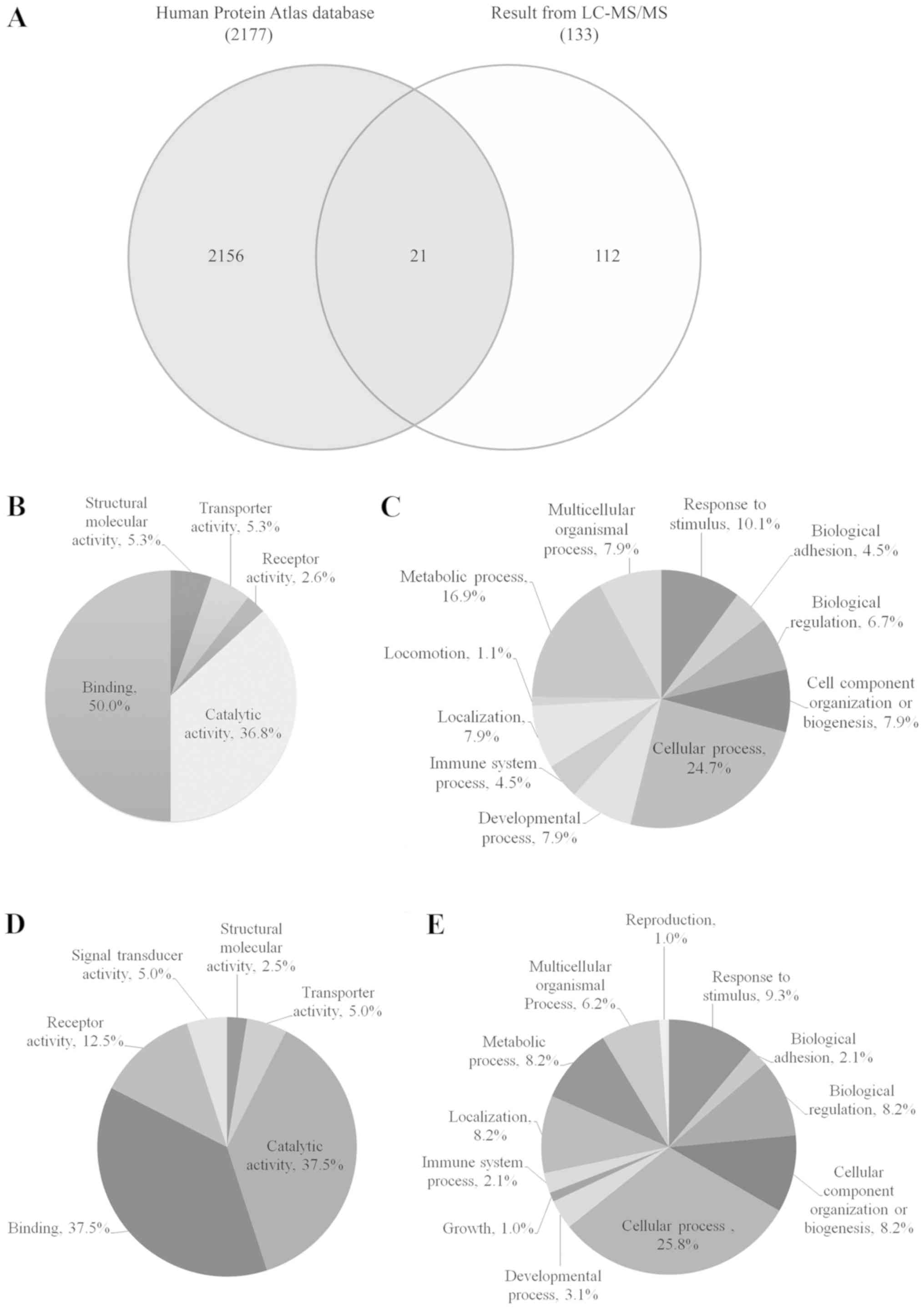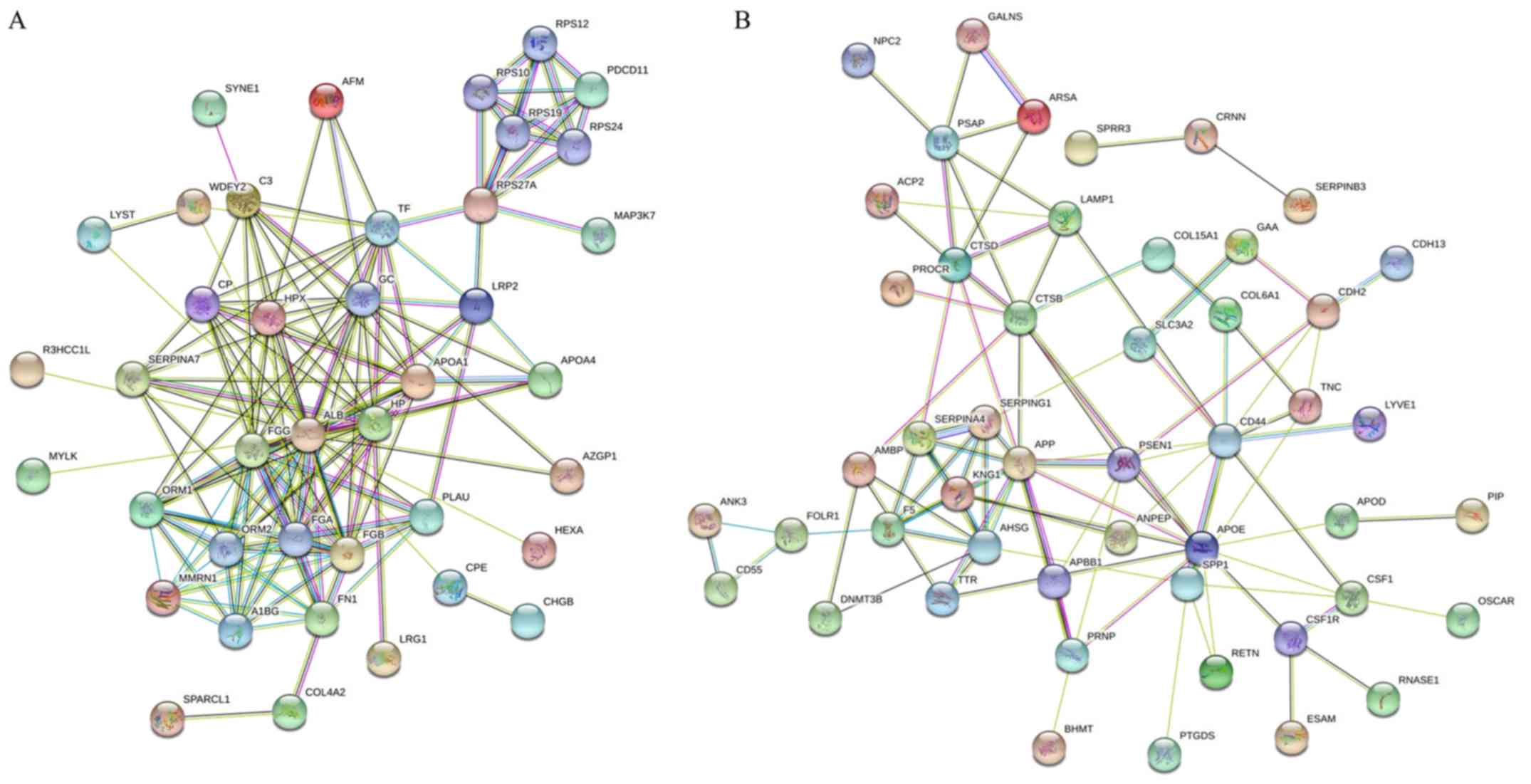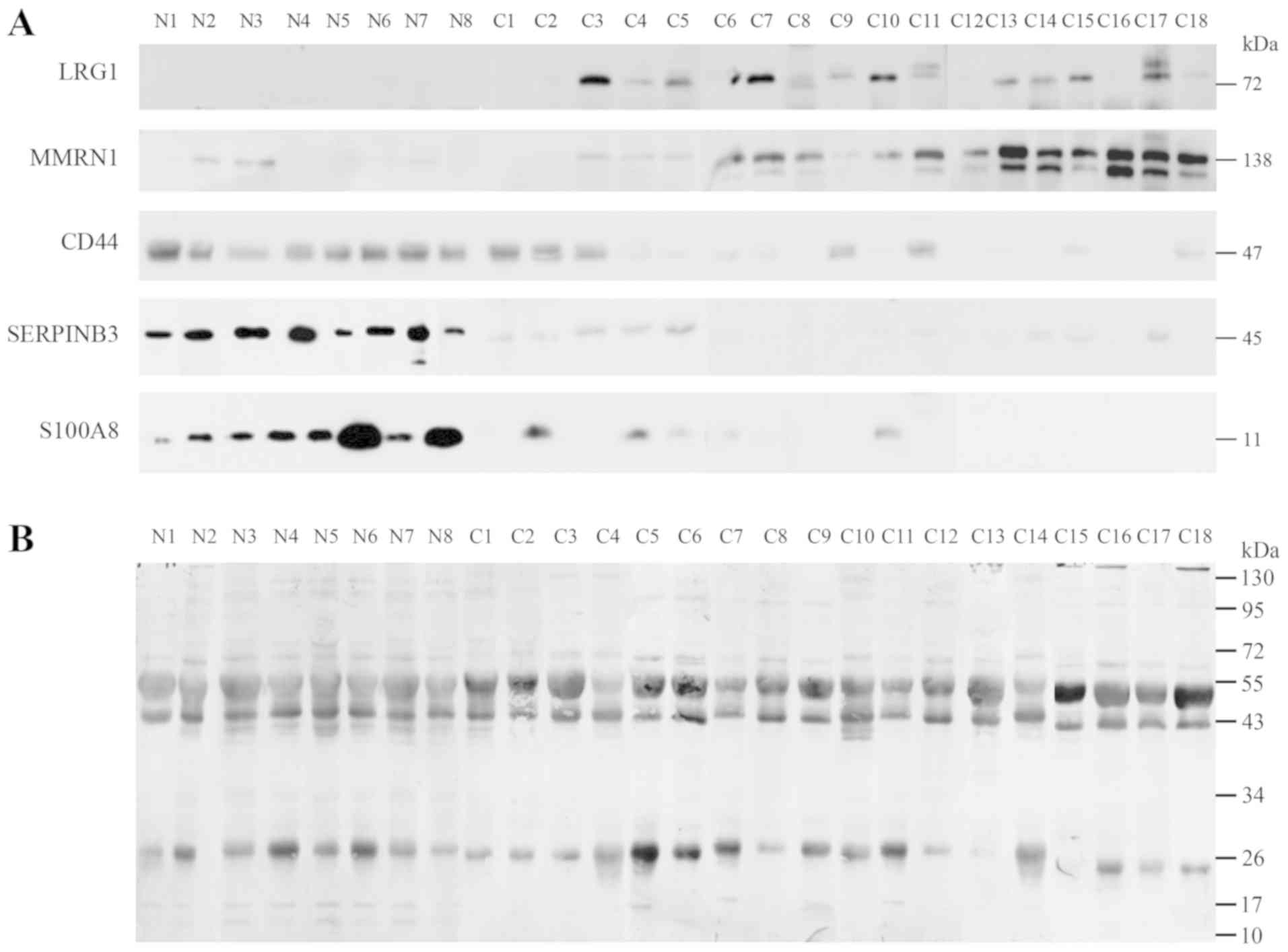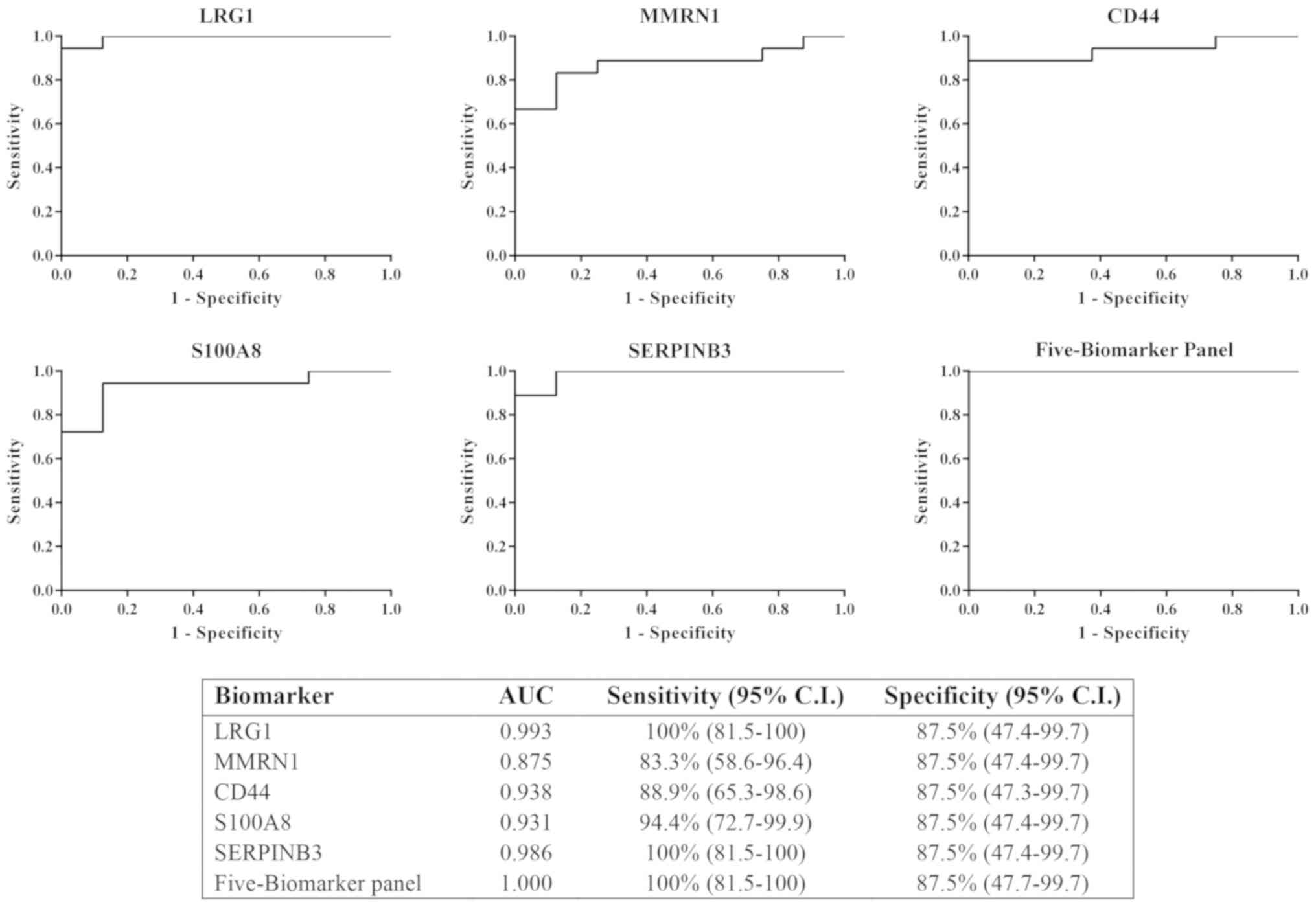|
1
|
Siegel RL, Miller KD and Jemal A: Cancer
statistics, 2016. CA Cancer J Clin. 66:7–30. 2016. View Article : Google Scholar : PubMed/NCBI
|
|
2
|
Ferlay J, Soerjomataram I, Ervik M,
Dikshit R, Eser S, Mathers CD, Rebelo M, Parkin DM, Forman D and
Bray F: GLOBOCAN 2012 v1.0, cancer incidence and mortality
worldwide: IARC cancer base No. 11 [Internet] (Lyon, France).
International Agency for Research on Cancer. 2013.http://globocan.iarc.frDecember 10–2016
|
|
3
|
von Knebel Doeberitz M, Reuschenbach M,
Schmidt D and Bergeron C: Biomarkers for cervical cancer screening:
The role of p16(INK4a) to highlight transforming HPV infections.
Expert Rev Proteomics. 9:149–163. 2012. View Article : Google Scholar : PubMed/NCBI
|
|
4
|
Ferlay J, Soerjomataram I, Dikshit R, Eser
S, Mathers C, Rebelo M, Parkin DM, Forman D and Bray F: Cancer
incidence and mortality worldwide: Sources, methods and major
patterns in GLOBOCAN 2012. Int J Cancer. 136:E359–E386. 2015.
View Article : Google Scholar : PubMed/NCBI
|
|
5
|
Ostör AG: Natural history of cervical
intraepithelial neoplasia: A critical review. Int J Gynecol Pathol.
12:186–192. 1993. View Article : Google Scholar : PubMed/NCBI
|
|
6
|
Van Keer S, Pattyn J, Tjalma WAA, Van
Ostade X, Ieven M, Van Damme P and Vorsters A: First-void urine: A
potential biomarker source for triage of high-risk human
papillomavirus infected women. Eur J Obstet Gynecol Reprod Biol.
216:1–11. 2017. View Article : Google Scholar : PubMed/NCBI
|
|
7
|
Ng HT, Yen MS, Chao KC, Chen CY and Yuan
CC: Radical hysterectomy: Past, present, and future. Eur J Gynaecol
Oncol. 26:585–588. 2005.PubMed/NCBI
|
|
8
|
Hoffman MS: Extent of radical
hysterectomy: Evolving emphasis. Gynecol Oncol. 94:1–9. 2004.
View Article : Google Scholar : PubMed/NCBI
|
|
9
|
Umanzor J, Aguiluz M, Pineda C, Andrade S,
Erazo M, Flores C and Santillana S: Concurrent
cisplatin/gemcitabine chemotherapy along with radiotherapy in
locally advanced cervical carcinoma: A phase II trial. Gynecol
Oncol. 100:70–75. 2006. View Article : Google Scholar : PubMed/NCBI
|
|
10
|
Tanaka T, Kokawa K and Umesaki N:
Preoperative chemotherapy with irinotecan and mitomycin for FIGO
stage IIIb cervical squamous cell carcinoma: A pilot study. Eur J
Gynaecol Oncol. 26:605–607. 2005.PubMed/NCBI
|
|
11
|
Linghu H, Xu XR, Mei YY, Tang JY, Tang LD
and Sun T: Response of early stage bulky cervical squamous
carcinoma to preoperative adjuvant chemotherapy. Chin Med Sci J.
19:116–119. 2004.PubMed/NCBI
|
|
12
|
Candelaria M, Garcia-Arias A, Cetina L and
Dueñas-Gonzalez A: Radiosensitizers in cervical cancer. Cisplatin
and beyond. Radiat Oncol. 1:152006. View Article : Google Scholar : PubMed/NCBI
|
|
13
|
Goto T, Kino N, Shirai T, Fujimura M,
Takahashi M and Shiromizu K: Late recurrence of invasive cervical
cancer: Twenty years' experience in a single cancer institute. J
Obstet Gynaecol Res. 31:514–519. 2005. View Article : Google Scholar : PubMed/NCBI
|
|
14
|
Anderson NG, Anderson NL and Tollaksen SL:
Proteins of human urine. I. Concentration and analysis by
two-dimensional electrophoresis. Clin Chem. 25:1199–1210.
1979.PubMed/NCBI
|
|
15
|
Aobchey T, Niamsup H, Siriaree S, Sookkheo
B, Boonyapranai K and Chen ST: Proteomic analysis of candidate
prognostic urinary marker for cervical cancer. J Proteomics
Bioinform. 6:245–251. 2013. View Article : Google Scholar
|
|
16
|
Cox J, Hein MY, Luber CA, Paron I, Nagaraj
N and Mann M: Accurate proteome-wide label-free quantification by
delayed normalization and maximal peptide ratio extraction, termed
MaxLFQ. Mol Cell Proteomics. 13:2513–2526. 2014. View Article : Google Scholar : PubMed/NCBI
|
|
17
|
Wong JW and Cagney G: An overview of
label-free quantitation methods in proteomics by mass spectrometry.
Methods Mol Biol. 604:273–283. 2010. View Article : Google Scholar : PubMed/NCBI
|
|
18
|
Apgar BS, Zoschnick L and Wright Jr TC:
The 2001 Bethesda system terminology. Am Fam Physician.
68:1992–1998. 2003.PubMed/NCBI
|
|
19
|
Kantathavorn N, Mahidol C, Sritana N,
Sricharunrat T, Phoolcharoen N, Auewarakul C, Teerayathanakul N,
Taepisitpong C, Saeloo S, Sornsamdang G, et al: Genotypic
distribution of human papillomavirus (HPV) and cervical cytology
findings in 5906 Thai women undergoing cervical cancer screening
programs. Infect Agent Cancer. 10:72015. View Article : Google Scholar : PubMed/NCBI
|
|
20
|
Bradford MM: A rapid and sensitive method
for the quantitation of microgram quantities of protein utilizing
the principle of protein-dye binding. Anal Biochem. 72:248–254.
1976. View Article : Google Scholar : PubMed/NCBI
|
|
21
|
Beetham R and Cattell WR: Proteinuria:
Pathophysiology, significance and recommendations for measurement
in clinical practice. Ann Clin Biochem. 30:425–434. 1993.
View Article : Google Scholar : PubMed/NCBI
|
|
22
|
Pappa KI, Lygirou V, Kontostathi G,
Zoidakis J, Makridakis M, Vougas K, Daskalakis G, Polyzos A and
Anagnou NP: Proteomic analysis of normal and cancer cervical cell
lines reveals deregulation of cytoskeleton-associated proteins.
Cancer Genomics Proteomics. 14:253–266. 2017. View Article : Google Scholar : PubMed/NCBI
|
|
23
|
Zhang HT, Tian EB, Chen YL, Deng HT and
Wang QT: Proteomic analysis for finding serum pathogenic factors
and potential biomarkers in multiple myeloma. Chin Med J (Engl).
128:1108–1113. 2015. View Article : Google Scholar : PubMed/NCBI
|
|
24
|
Välk K, Vooder T, Kolde R, Reintam MA,
Petzold C, Vilo J and Metspalu A: Gene expression profiles of
non-small cell lung cancer: Survival prediction and new biomarkers.
Oncology. 79:283–292. 2010. View Article : Google Scholar : PubMed/NCBI
|
|
25
|
He X, Wang Y, Zhang W, Li H, Luo R, Zhou
Y, Liao CL, Huang H, Lv X, Xie Z and He M: Screening differential
expression of serum proteins in AFP-negative HBV-related
hepatocellular carcinoma using iTRAQ-MALDI-MS/MS. Neoplasma.
61:17–26. 2014. View Article : Google Scholar : PubMed/NCBI
|
|
26
|
Furukawa K, Kawamoto K, Eguchi H, Tanemura
M, Tanida T, Tomimaru Y, Akita H, Hama N, Wada H, Kobayashi S, et
al: Clinicopathological significance of leucine-rich
α2-glycoprotein-1 in sera of patients with pancreatic cancer.
Pancreas. 44:93–98. 2015. View Article : Google Scholar : PubMed/NCBI
|
|
27
|
Wu J, Xie X, Nie S, Buckanovich RJ and
Lubman DM: Altered expression of sialylated glycoproteins in
ovarian cancer sera using lectin-based ELISA assay and quantitative
glycoproteomics analysis. J Proteome Res. 12:3342–3352. 2013.
View Article : Google Scholar : PubMed/NCBI
|
|
28
|
Khammanivong A, Wang C, Sorenson BS, Ross
KF and Herzberg MC: S100A8/A9 (calprotectin) negatively regulates
G2/M cell cycle progression and growth of squamous cell carcinoma.
PLoS One. 8:e693952013. View Article : Google Scholar : PubMed/NCBI
|
|
29
|
Silva EJ, Argyris PP, Zou X, Ross KF and
Herzberg MC: S100A8/A9 regulates MMP-2 expression and invasion and
migration by carcinoma cells. Int J Biochem Cell Biol. 55:279–287.
2014. View Article : Google Scholar : PubMed/NCBI
|
|
30
|
Hermani A, Hess J, De Servi B, Medunjanin
S, Grobholz R, Trojan L, Angel P and Mayer D: Calcium-binding
proteins S100A8 and S100A9 as novel diagnostic markers in human
prostate cancer. Clin Cancer Res. 11:5146–5152. 2005. View Article : Google Scholar : PubMed/NCBI
|
|
31
|
Wang L, Chang EW, Wong SC, Ong SM, Chong
DQ and Ling KL: Increased myeloid-derived suppressor cells in
gastric cancer correlate with cancer stage and plasma S100A8/A9
proinflammatory proteins. J Immunol. 190:794–804. 2013. View Article : Google Scholar : PubMed/NCBI
|
|
32
|
Ito Y, Arai K, Nozawa R, Yoshida H,
Hirokawa M, Fukushima M, Inoue H, Tomoda C, Kihara M, Higashiyama
T, et al: S100A8 and S100A9 expression is a crucial factor for
dedifferentiation in thyroid carcinoma. Anticancer Res.
29:4157–4161. 2009.PubMed/NCBI
|
|
33
|
Duan L, Wu R, Ye L, Wang H, Yang X, Zhang
Y, Chen X, Zuo G, Zhang Y, Weng Y, et al: S100A8 and S100A9 are
associated with colorectal carcinoma progression and contribute to
colorectal carcinoma cell survival and migration via Wnt/β-catenin
pathway. PLoS One. 8:e620922013. View Article : Google Scholar : PubMed/NCBI
|
|
34
|
Ott HW, Lindner H, Sarg B, Mueller-Holzner
E, Abendstein B, Bergant A, Fessler S, Schwaerzler P, Zeimet A,
Marth C and Illmensee K: Calgranulins in cystic fluid and serum
from patients with ovarian carcinomas. Cancer Res. 63:7507–7514.
2003.PubMed/NCBI
|
|
35
|
Minami S, Sato Y, Matsumoto T, Kageyama T,
Kawashima Y, Yoshio K, Ishii J, Matsumoto K, Nagashio R and Okayasu
I: Proteomic study of sera from patients with bladder cancer:
Usefulness of S100A8 and S100A9 proteins. Cancer Genomics
Proteomics. 7:181–189. 2010.PubMed/NCBI
|
|
36
|
El Gammal AT, Sturm JH, Pinnschmidt HO,
Hofmann BT, Bellon E, Ghadban T, Melling NT, Bachmann KA, Izbicki
J, Bockhorn M, et al: Protein S100A8/A9: A potential new biomarker
for pancreatic diseases. Int J Clin Endocrinol Metab. 3:23–28.
2017. View Article : Google Scholar
|
|
37
|
Tugizov S, Berline J, Herrera R, Penaranda
ME, Nakagawa M and Palefsky J: Inhibition of human papillomavirus
type 16 E7 phosphorylation by the S100 MRP-8/14 protein complex. J
Virol. 79:1099–1112. 2005. View Article : Google Scholar : PubMed/NCBI
|
|
38
|
Kong JP, Ding F, Zhou CN, Wang XQ, Miao
XP, Wu M and Liu ZH: Loss of myeloid-related proteins 8 and
myeloid-related proteins 14 expression in human esophageal squamous
cell carcinoma correlates with poor differentiation. World J
Gastroenterol. 10:1093–1097. 2004. View Article : Google Scholar : PubMed/NCBI
|
|
39
|
Wang J, Cai Y, Xu H, Zhao J, Xu X, Han YL,
Xu ZX, Chen BS, Hu H, Wu M and Wang MR: Expression of MRP14 gene is
frequently down-regulated in Chinese human esophageal cancer. Cell
Res. 14:46–53. 2004. View Article : Google Scholar : PubMed/NCBI
|
|
40
|
Argyris PP, Slama ZM, Ross KF,
Khammanivong A and Herzberg MC: Calprotectin and the initiation and
progression of head and neck cancer. J Dent Res. 97:674–682. 2018.
View Article : Google Scholar : PubMed/NCBI
|
|
41
|
Khammanivong A, Sorenson BS, Ross KF,
Dickerson EB, Hasina R, Lingen MW and Herzberg MC: Involvement of
calprotectin (S100A8/A9) in molecular pathways associated with
HNSCC. Oncotarget. 7:14029–14047. 2016. View Article : Google Scholar : PubMed/NCBI
|
|
42
|
Dalchau R, Kirkley J and Fabre JW:
Monoclonal antibody to a human leukocyte-specific membrane
glycoprotein probably homologous to the leukocyte-common (L-C)
antigen of the rat. Eur J Immunol. 10:737–744. 1980. View Article : Google Scholar : PubMed/NCBI
|
|
43
|
Kosunen A, Pirinen R, Ropponen K, Pukkila
M, Kellokoski J, Virtaniemi J, Sironen R, Juhola M, Kumpulainen E,
Johansson R, et al: CD44 expression and its relationship with
MMP-9, clinicopathological factors and survival in oral squamous
cell carcinoma. Oral Oncol. 43:51–59. 2007. View Article : Google Scholar : PubMed/NCBI
|
|
44
|
Mostaan LV, Khorsandi MT, Sharifian SM,
Shandiz FH, Mirashrafi F, Sabzari H, Badiee R, Borghei H and
Yazdani N: Correlation between E-cadherin and CD44 adhesion
molecules expression and cervical lymph node metastasis in oral
tongue SCC: Predictive significance or not. Pathol Res Pract.
207:448–451. 2011. View Article : Google Scholar : PubMed/NCBI
|
|
45
|
Urquidi V, Kim J, Chang M, Dai Y, Rosser
CJ and Goodison S: CCL18 in a multiplex urine-based assay for the
detection of bladder cancer. PLoS One. 7:e377972012. View Article : Google Scholar : PubMed/NCBI
|
|
46
|
Arville B, O'Rourke E, Chung F, Amin M and
Bose S: Evaluation of a triple combination of cytokeratin 20, p53
and CD44 for improving detection of urothelial carcinoma in urine
cytology specimens. Cytojournal. 10:252013. View Article : Google Scholar : PubMed/NCBI
|
|
47
|
Xiao S, Zhou Y, Jiang J, Yuan L and Xue M:
CD44 affects the expression level of FOS-like antigen 1 in cervical
cancer tissues. Mol Med Rep. 9:1667–1674. 2014. View Article : Google Scholar : PubMed/NCBI
|
|
48
|
Wobus M, Kuns R, Wolf C, Horn LC, Köhler
U, Sheyn I, Werness BA and Sherman LS: CD44 mediates constitutive
type I receptor signaling in cervical carcinoma cells. Gynecol
Oncol. 83:227–234. 2001. View Article : Google Scholar : PubMed/NCBI
|
|
49
|
Kato H: Expression and function of
squamous cell carcinoma antigen. Anticancer Res. 16:2149–2153.
1996.PubMed/NCBI
|
|
50
|
Sun Y, Sheshadri N and Zong WX: SERPINB3
and B4: From biochemistry to biology. Semin Cell Dev Biol.
62:170–177. 2017. View Article : Google Scholar : PubMed/NCBI
|
|
51
|
Hamanaka S, Ujihara M, Numa F and Kato H:
Serum level of squamous cell carcinoma antigen as a new indicator
of disease activity in patients with psoriasis. Arch Dermatol.
133:393–395. 1997. View Article : Google Scholar : PubMed/NCBI
|
|
52
|
Vidalino L, Doria A, Quarta S, Zen M,
Gatta A and Pontisso P: SERPINB3, apoptosis and autoimmunity.
Autoimmun Rev. 9:108–112. 2009. View Article : Google Scholar : PubMed/NCBI
|
|
53
|
Nakashima T, Yasumatsu R, Kuratomi Y,
Masuda M, Kuwano T, Toh S, Umezaki T, Cataltepe S, Silverman GA and
Komune S: Role of squamous cell carcinoma antigen 1 expression in
the invasive potential of head and neck squamous cell carcinoma.
Head Neck. 28:24–30. 2006. View Article : Google Scholar : PubMed/NCBI
|













